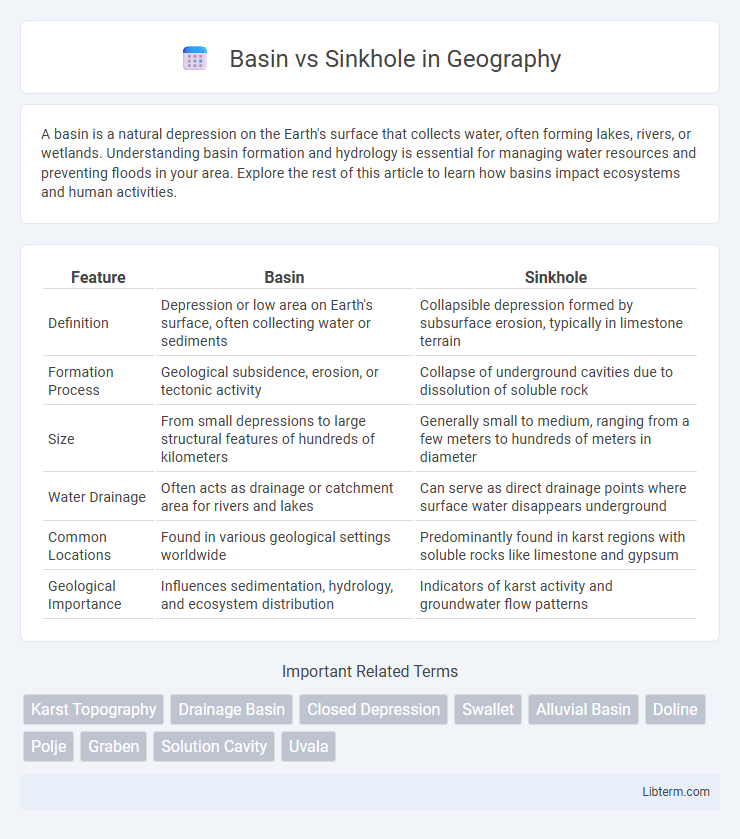A basin is a natural depression on the Earth's surface that collects water, often forming lakes, rivers, or wetlands. Understanding basin formation and hydrology is essential for managing water resources and preventing floods in your area. Explore the rest of this article to learn how basins impact ecosystems and human activities.
Table of Comparison
| Feature | Basin | Sinkhole |
|---|---|---|
| Definition | Depression or low area on Earth's surface, often collecting water or sediments | Collapsible depression formed by subsurface erosion, typically in limestone terrain |
| Formation Process | Geological subsidence, erosion, or tectonic activity | Collapse of underground cavities due to dissolution of soluble rock |
| Size | From small depressions to large structural features of hundreds of kilometers | Generally small to medium, ranging from a few meters to hundreds of meters in diameter |
| Water Drainage | Often acts as drainage or catchment area for rivers and lakes | Can serve as direct drainage points where surface water disappears underground |
| Common Locations | Found in various geological settings worldwide | Predominantly found in karst regions with soluble rocks like limestone and gypsum |
| Geological Importance | Influences sedimentation, hydrology, and ecosystem distribution | Indicators of karst activity and groundwater flow patterns |
Introduction to Basins and Sinkholes
Basins are large depressions in the earth's surface that collect sediment, water, and organic materials over time, playing a crucial role in geological formations and ecosystems. Sinkholes are smaller, often circular collapses in the ground caused by the dissolution of soluble bedrock such as limestone, leading to sudden surface subsidence. Both basins and sinkholes significantly influence hydrology, landscape development, and environmental stability.
Defining Basins: Key Features
Basins are large-scale geological depressions that collect and store water or sediment, often characterized by their broad, bowl-like shape and drainage patterns. They serve as natural reservoirs, influencing hydrology and ecosystem dynamics by channeling runoff from surrounding areas. Unlike sinkholes, basins form through sediment accumulation and tectonic processes rather than abrupt collapse.
What is a Sinkhole? Characteristics Explained
A sinkhole is a natural depression or hole in the Earth's surface caused by the collapse of underlying limestone or other soluble rock due to water erosion. Characteristic features include sudden formation, varying size from a few feet to hundreds of acres, and often a circular shape with steep edges. Sinkholes differ from basins as they form primarily through geological processes like dissolution and collapse, whereas basins are large-scale landforms created by tectonic activity or sediment accumulation.
Geological Formation of Basins
Basins are geological depressions formed through processes such as crustal subsidence, sediment accumulation, and tectonic activity, creating large-scale depressions that collect sediments over time. Unlike sinkholes, which result from localized collapse of soluble rock layers like limestone due to dissolution, basins develop over extended geological periods through plate movements and sedimentation patterns. Their formation often leads to significant sedimentary deposits that influence fossil records and hydrocarbon reservoirs.
How Sinkholes Develop: Causes and Processes
Sinkholes develop primarily through the dissolution of soluble bedrock such as limestone, gypsum, or salt by acidic groundwater, creating underground voids that collapse surface land. This process is known as karstification, where chemical weathering enlarges subterranean cavities over time. Human activities like excessive groundwater extraction and construction can accelerate sinkhole formation by destabilizing these underground cavities.
Differences Between Basins and Sinkholes
Basins are large-scale depressions that collect water and sediments over time, often formed by tectonic activity or erosion, while sinkholes are smaller, sudden collapses of the ground caused by the dissolution of limestone or other soluble rocks. Basins typically serve as natural reservoirs in river systems or lakes, whereas sinkholes create localized depressions that can alter drainage patterns abruptly. The scale, formation process, and impact on the surrounding landscape distinguish basins from sinkholes in geological and hydrological contexts.
Environmental Impact of Basins vs Sinkholes
Basins serve as natural water catchment areas that support biodiversity by maintaining wetlands and aquifers, promoting ecological balance. Sinkholes, however, cause sudden landscape collapses that disrupt ecosystems, contaminate groundwater sources, and pose hazards to human infrastructure. The environmental impact of sinkholes is often more severe due to their unpredictable formation and potential to alter surface and subsurface hydrology drastically.
Famous Basins and Sinkholes Around the World
Famous basins like the Amazon Basin, Great Basin in the US, and the Congo Basin are vast geographical depressions often characterized by extensive river systems and diverse ecosystems. Renowned sinkholes, such as the Great Blue Hole in Belize, the Xiaozhai Tiankeng in China, and the Dean's Blue Hole in the Bahamas, are dramatic vertical caverns formed by natural limestone erosion or the collapse of underground voids. Both basins and sinkholes serve as important geological features studied for their unique formation processes and ecological significance.
Human Activity and Its Effect on Basins and Sinkholes
Human activities such as groundwater extraction, mining, and construction significantly influence the formation and stability of basins and sinkholes by altering natural water flow and soil structure. Over-pumping groundwater in basins can lead to land subsidence, increasing the risk of sinkhole development in karst regions where soluble rock is present. Urbanization and deforestation exacerbate these effects by disrupting drainage patterns and accelerating erosion, thereby intensifying the potential for sinkhole collapse and basin degradation.
Importance of Understanding Basins and Sinkholes
Understanding basins and sinkholes is crucial for managing water resources and mitigating geological hazards. Basins serve as natural catchment areas that influence flood control, groundwater recharge, and ecosystem sustainability. Sinkholes pose serious risks to infrastructure and safety due to ground collapse, necessitating accurate identification and monitoring in karst terrain.
Basin Infographic

 libterm.com
libterm.com